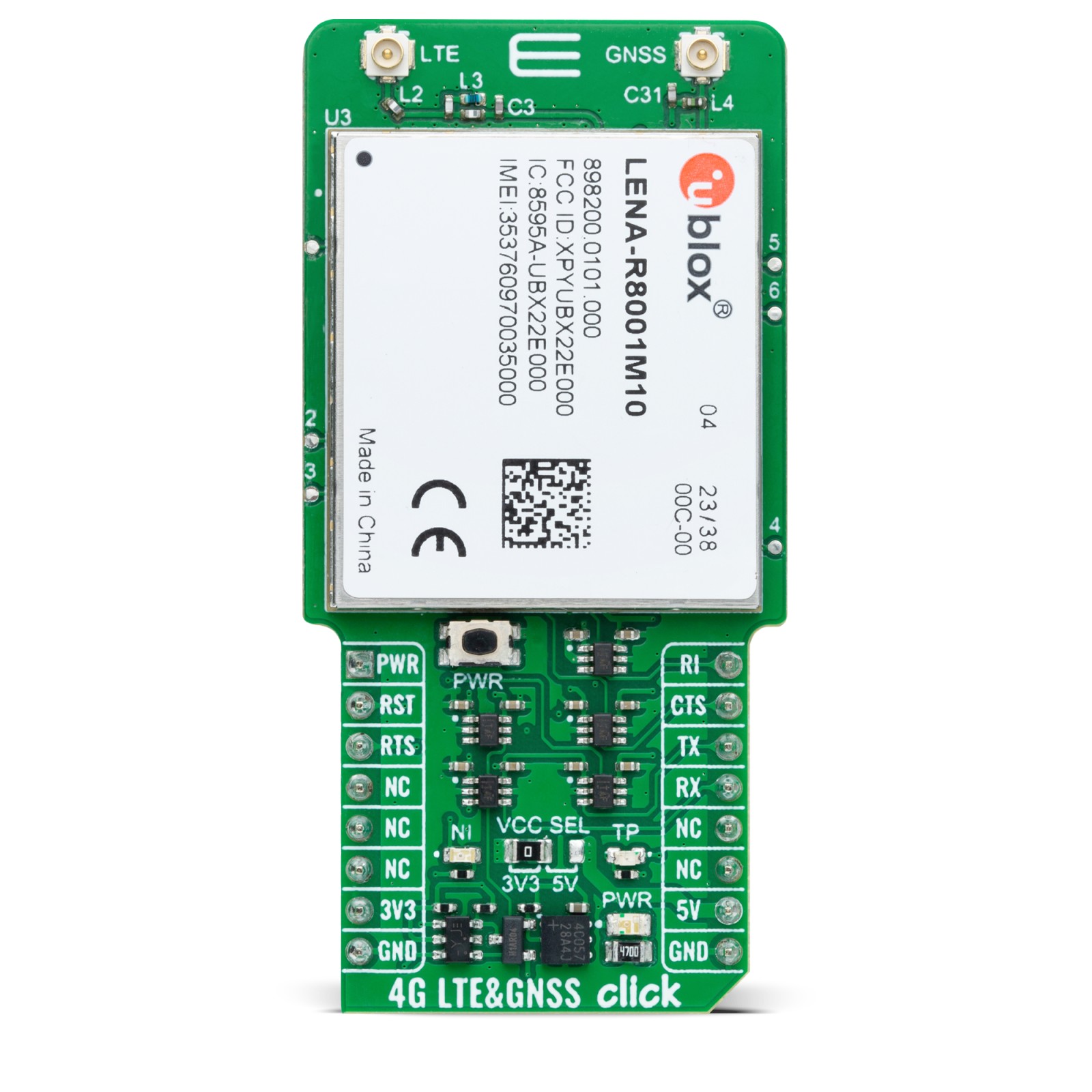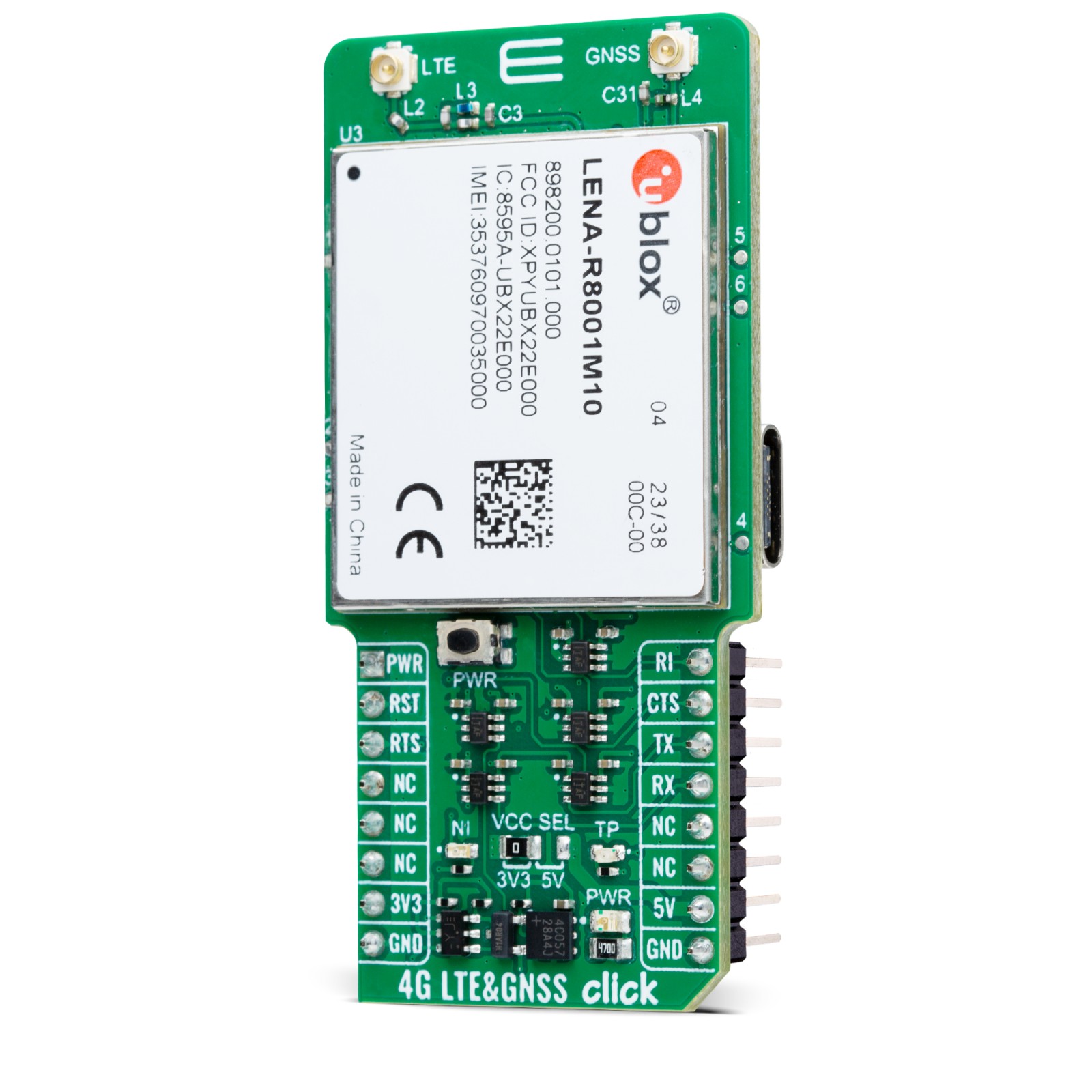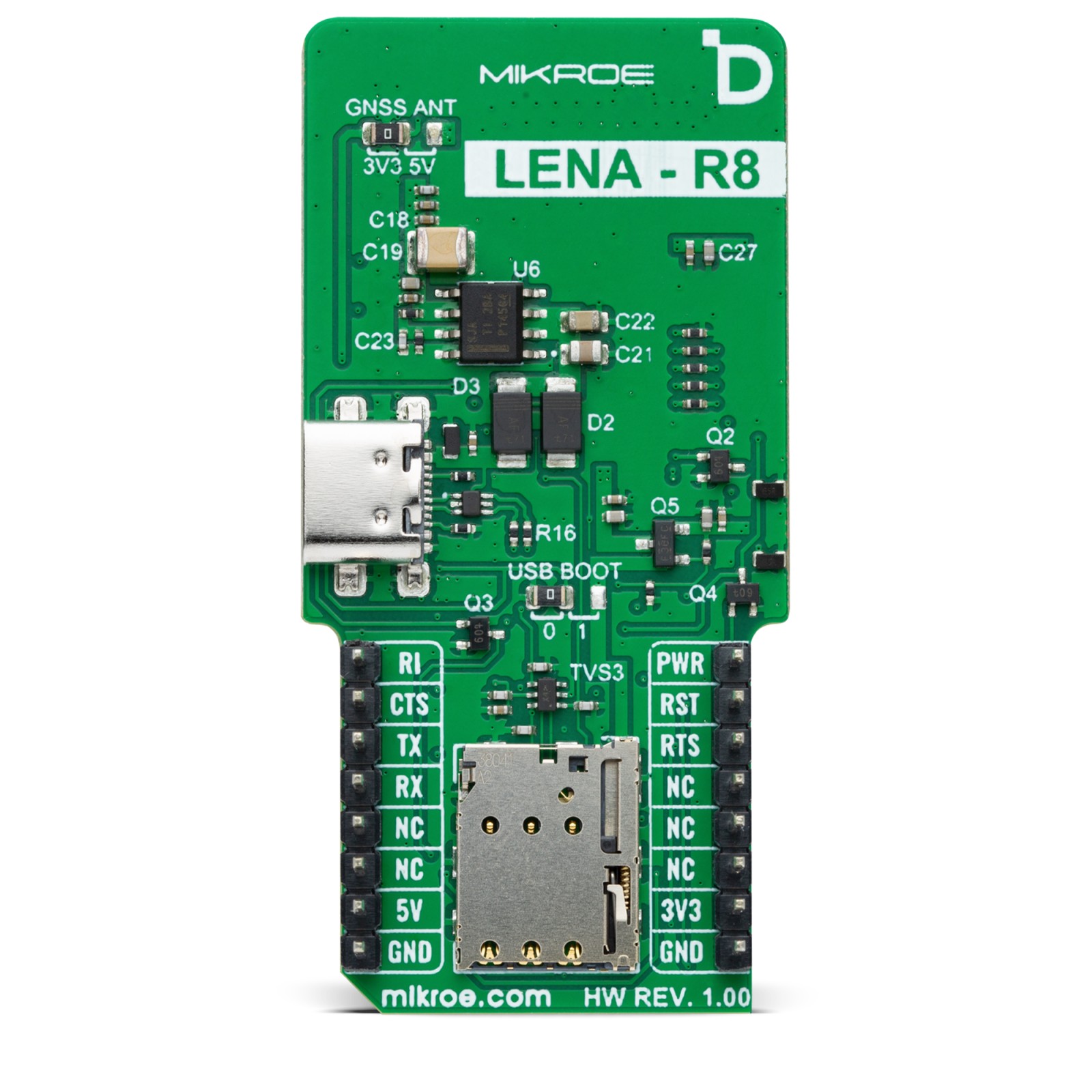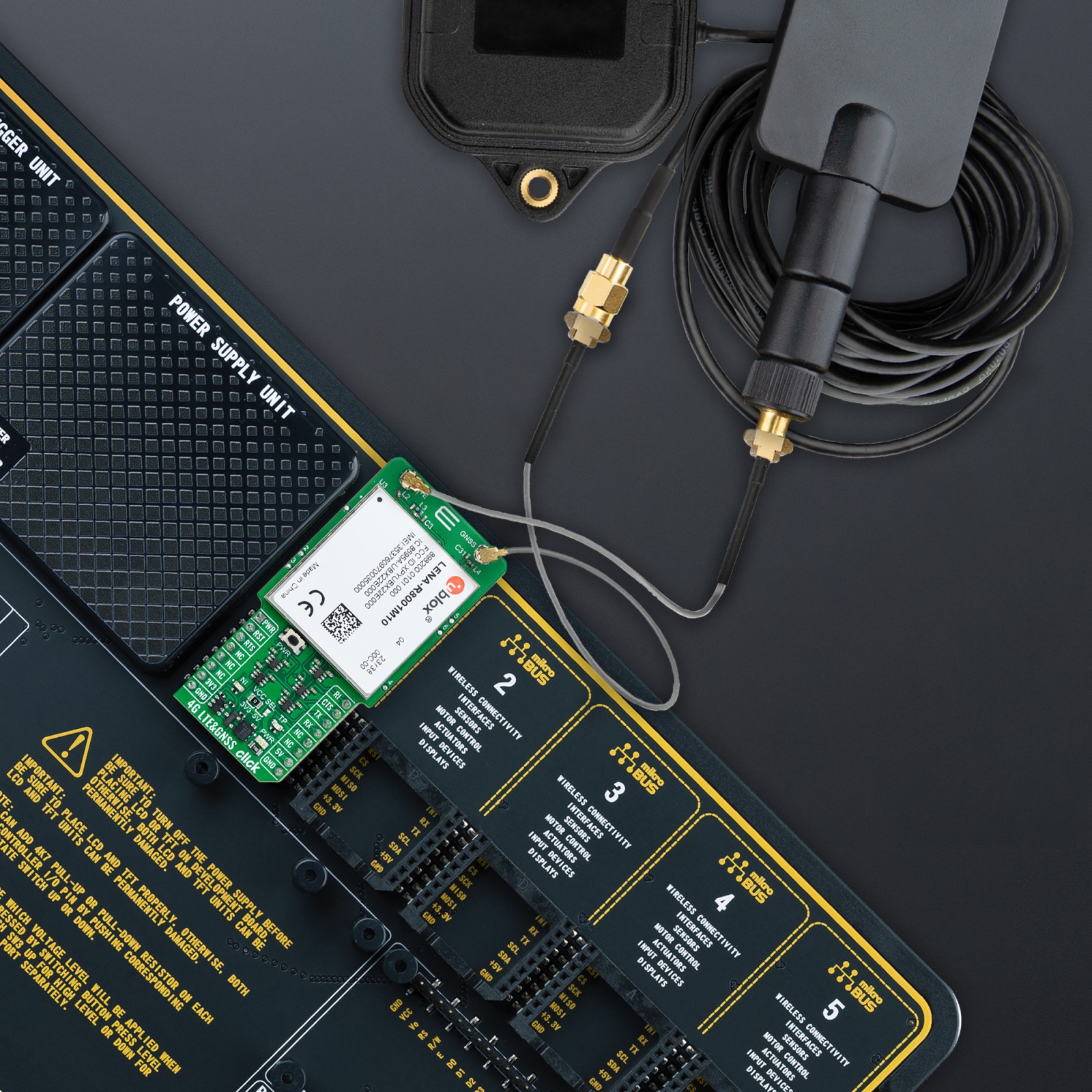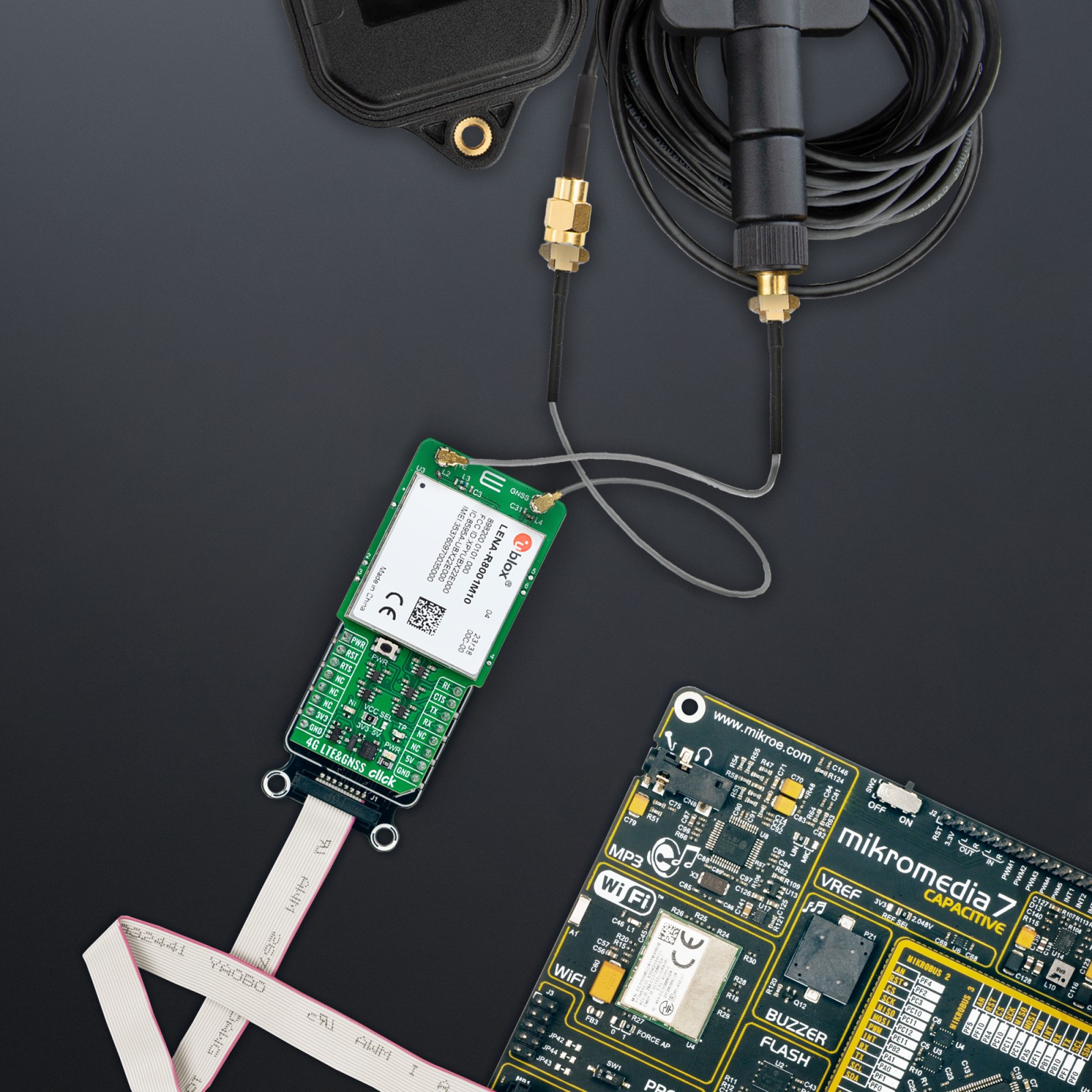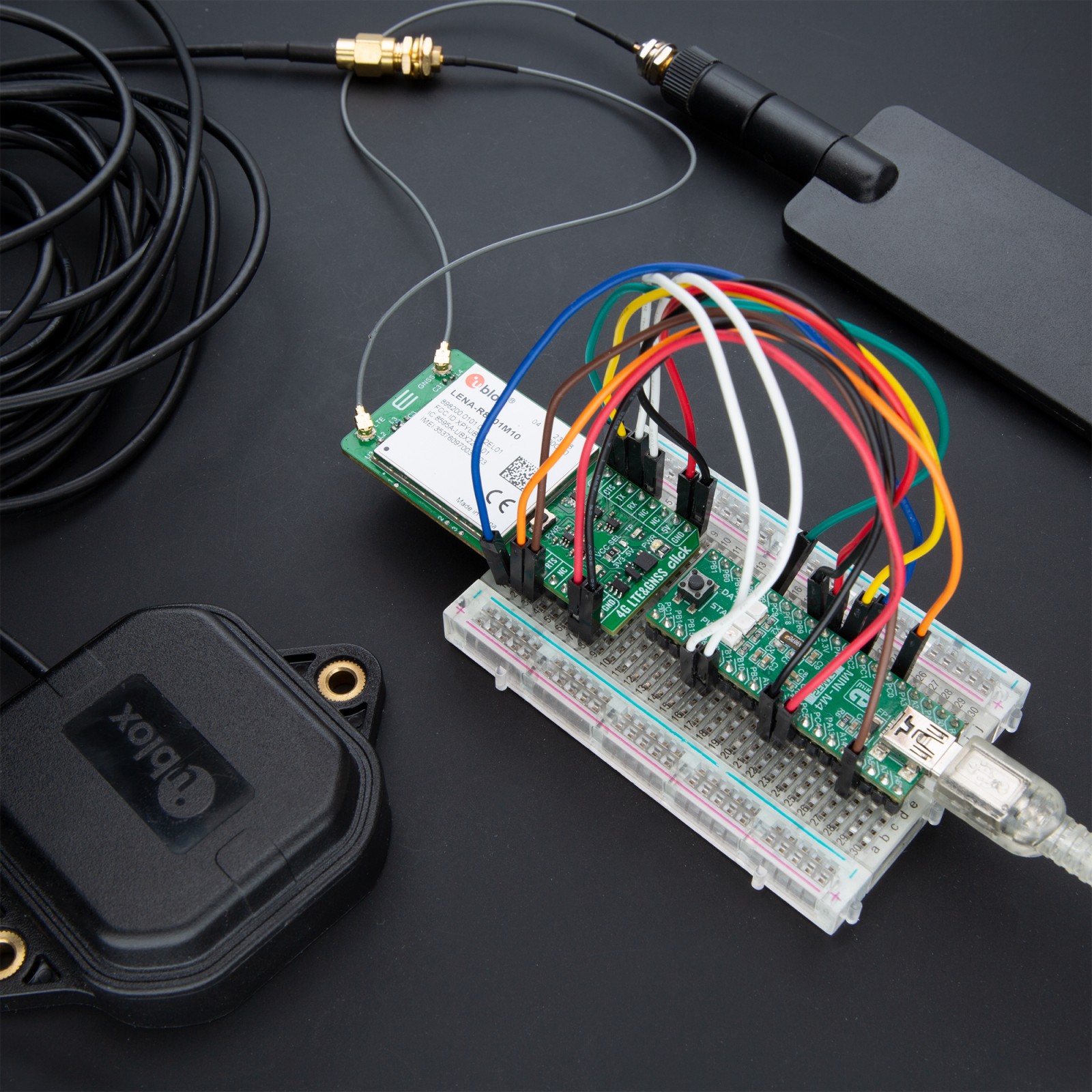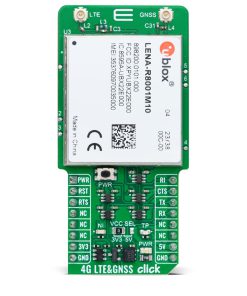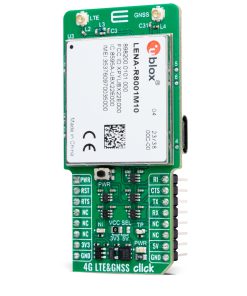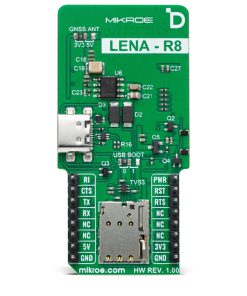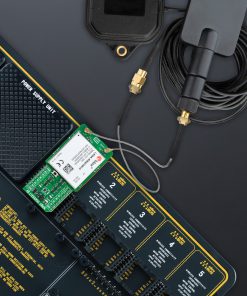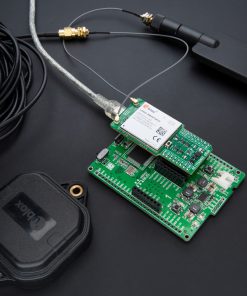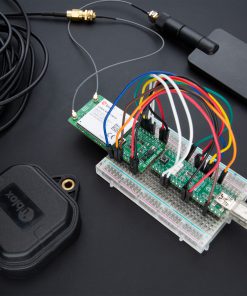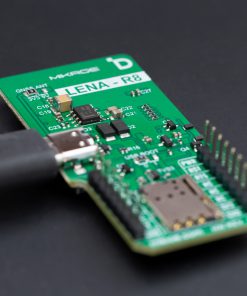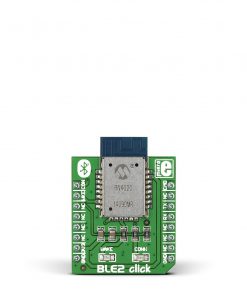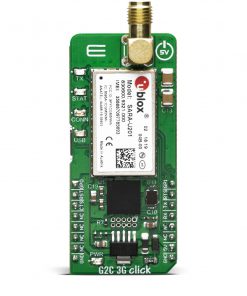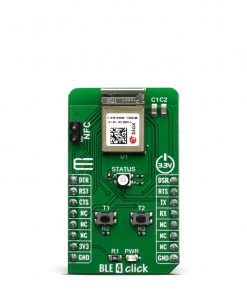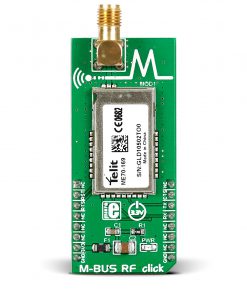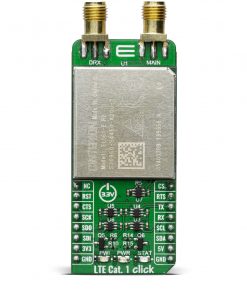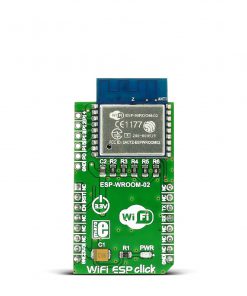Subtotal: R790.00
4G LTE&GNSS Click
R2,350.00 ex. VAT
4G LTE&GNSS Click is a compact add-on board designed for advanced global tracking and telematics applications, enabling developers to build highly efficient and smaller solutions without compromising performance. This board features the LENA-R8, a multi-mode LTE Cat 1bis module from u-blox. It stands out for its compact size and extensive network compatibility. It supports 14 LTE bands, four GSM/GPRS bands for universal connectivity, and integrated u-blox GNSS for precise global tracking. The board facilitates seamless communication via UART and includes a USB interface for comprehensive device management and firmware updates. Key features include dual LED indicators for operational status, flexible power options, and a nano SIM card holder supporting various SIM voltages. Ideally suited for IoT applications requiring broad global coverage and high-performance location services, the 4G LTE&GNSS Click board is a powerful tool for developers in the tracking and telematics markets.
4G LTE&GNSS Click is fully compatible with the mikroBUS™ socket and can be used on any host system supporting the mikroBUS™ standard. It comes with the mikroSDK open-source libraries, offering unparalleled flexibility for evaluation and customization. What sets this Click board™ apart is the groundbreaking ClickID feature, enabling your host system to seamlessly and automatically detect and identify this add-on board.
Stock: Lead-time applicable.
| 5+ | R2,232.50 |
| 10+ | R2,115.00 |
| 15+ | R1,997.50 |
| 20+ | R1,922.30 |
How does it work?
4G LTE&GNSS Click is based on the LENA-R8 (LENA-R8001M10-00C), a multi-mode LTE Cat 1bis module with wide network support from u-blox. This cellular module has 14 LTE bands and four GSM/GPRS bands, delivering universal network connectivity and comprehensive global coverage. Its integrated u-blox GNSS functionality positions it as a premier choice for global tracking and telematics applications, where precision and reliability are paramount. The LENA-R8’s capability to support connectivity and location services natively simplifies the deployment of devices in cloud-based ecosystems, offering streamlined solutions for Connectivity as a Service (CaaS) and Location as a Service (LaaS). This makes it an invaluable component for developers seeking to create smaller, more efficient solutions without compromising GNSS performance or global accessibility.

Beyond its global LTE Cat 1bis connectivity, the LENA-R8 excels in facilitating a wide array of IoT applications, particularly in the tracking and telematics domains. Its compatibility with a broad spectrum of LTE and 2G bands ensures optimal roaming coverage across different geographical regions, enabling the creation of IoT devices that are truly global with a single product SKU. The module’s high level of integration includes support for MQTT Anywhere services on the Thingstream platform, enhancing its utility for seamless global roaming. It also boasts concurrent reception capabilities for up to four GNSS (GPS, GLONASS, Galileo, and BeiDou), with GPS and Galileo being the default configuration. This multifunctionality, combined with dedicated interfaces for the cellular modem and GNSS subsystems, allows for independent operation and flexible usage, optimizing performance and power efficiency. The LENA-R8’s support for CellLocate, a network-based location service, further underscores its versatility and suitability for a wide range of high-performance, location-dependent applications.
The LENA-R8 communicates with the host MCU using the UART interface with commonly used UART RX and TX pins with the hardware flow control pins UART CTS, RTS, RI (Clear to Send, Ready to Send, and Ring Indicator). It operates at 115200 bps by default configuration to transmit and exchange data with the host MCU. Besides UART pins, this Click board™ also uses an RST pin as an abrupt hardware reset of LENA-R8. This reset is performed without storing the current parameter settings, and a clean network detach.
The LENA-R8 also includes a USB High-Speed 2.0 compliant interface with a maximum 480 Mbit/s data rate. The module itself acts as a USB device and can be connected to any compatible USB host. The interface is available for communication with the external host application processor (AT commands, data, FW update by means of FOAT), FW update by means of a dedicated tool, and diagnostics. In addition, on the back side of the board, there is a USB BOOT jumper that allows you to select the Boot mode. By placing it at position 1, the FW update by the dedicated tool over the USB interface is enabled, and at position 0 for boot in normal operating mode.
In addition to its integrated Power (PWR) button for manual activation, the LENA-R8 module can be powered through an external PWR pin. Furthermore, the module is equipped with two distinct LED indicators to visually convey critical operational status information. The yellow LED, labeled NI, serves as a network status indicator, offering immediate feedback on the module’s connectivity status within a network. This is crucial for troubleshooting and confirming successful network integration. Similarly, the red LED, labeled TP, acts as a time pulse indicator, emitting a precise signal to denote time synchronization events. This is especially beneficial for applications requiring high timing accuracy, such as time-sensitive data collection or GPS-based positioning.
The board features u.Fl connectors for LTE and GNSS antennas, accommodating accessories like the LTE Flat Rotation Antenna and the GNSS Active External Antenna, in combination with an IPEX-SMA cable for flexible and efficient connectivity options. This setup ensures optimal signal strength and quality for local and satellite communications. Notably, the GNSS antenna connection includes a power selection feature, allowing users to adjust the antenna’s power supply according to specific requirements, enhancing the precision and reliability of satellite navigation. Additionally, the board is equipped with a nano SIM card holder that supports both 1.8V and 3.0V SIM cards, ensuring compatibility with a wide range of cellular networks and allowing users to select the most appropriate service provider for their particular use case.
This Click board™ also uses the TPS7A7002, a Low-Dropout Regulator (LDO) from Texas Instruments, to generate the required 3.8V power supply necessary for the module’s optimal operation. This power is derived from the 5V mikroBUS™ power rail or a USB connection if available, ensuring versatility in power sourcing. The board is equipped with several test points for further diagnostics and operational adjustments. TP1 is dedicated to diagnosing the module’s internal conditions, providing a typical output of 1.8V when the cellular component of the module is activated. This allows for real-time monitoring of the module’s power state. TP2 presents the same function as the PWR pin, TP3 as Reset, and TP4 as USB Boot. TP5 and TP6 connect the GNSS UART, enabling serial communication between the internal u-blox M10 GNSS chipset and an external host. This feature allows for direct data exchange and configuration between the GNSS module and the host device, enhancing the module’s functionality and flexibility in GNSS applications.
This Click board™ can operate with either 3.3V or 5V logic voltage levels selected via the VCC SEL jumper. This way, both 3.3V and 5V capable MCUs can use the communication lines properly. Also, this Click board™ comes equipped with a library containing easy-to-use functions and an example code that can be used as a reference for further development.
Specifications
Type
GSM/LTE,4G LTE,GPS/GNSS,LTE Cat 1 bis
Applications
Ideal for IoT applications requiring broad global coverage and high-performance location services like tracking and telematics markets
On-board modules
LENA-R8 – multi-mode LTE Cat 1bis module with wide network support from u-blox
Key Features
14 LTE bands and four GSM/GPRS bands, global network connectivity and coverege, GNSS support for precise tracking and telematics, connectivity and location services (CaaS and LaaS applications), UART and USB interfaces, SIM card interface, test points for diagnostics and operational adjustments, and more
Interface
UART,USB
Feature
ClickID
Compatibility
mikroBUS™
Click board size
L (57.15 x 25.4 mm)
Input Voltage
3.3V or 5V
Pinout diagram
This table shows how the pinout on 4G LTE&GNSS Click corresponds to the pinout on the mikroBUS™ socket (the latter shown in the two middle columns).
Onboard settings and indicators
| Label | Name | Default | Description |
|---|---|---|---|
| LD1 | PWR | – | Power LED Indicator |
| LD2 | NI | – | Network Status LED Indicator |
| LD3 | TP | – | Timepulse LED Indicator |
| JP1 | VCC SEL | Left | Logic Voltage Level Selection 3V3/5V: Left position 3V3, Right position 5V |
| JP2 | GNSS ANT | Left | GNSS Antenna Supply Selection 3V3/5V: Left position 3V3, Right position 5V |
| JP3 | USB BOOT | Left | Cellular System Boot Mode Selection 0/1: Left position 0, Right position 1 |
| T1 | PWR | – | Cellular Power-ON Button |
4G LTE&GNSS Click electrical specifications
| Description | Min | Typ | Max | Unit |
|---|---|---|---|---|
| Supply Voltage | 3.3 | – | 5 | V |
| Frequency Range | 700 | – | 2600 | MHz |
| LTE Data Rate | – | – | 10 | Mbit/s |
| GNSS Data Rate | – | – | 10 | Mbit/s |
Software Support
We provide a library for the 4G LTE GNSS Click as well as a demo application (example), developed using MIKROE compilers. The demo can run on all the main MIKROE development boards.
Package can be downloaded/installed directly from NECTO Studio Package Manager(recommended), downloaded from our LibStock™ or found on Mikroe github account.
Library Description
This library contains API for 4G LTE GNSS Click driver.
Key functions
-
c4gltegnss_set_sim_apnThis function sets APN for sim card. -
c4gltegnss_send_sms_textThis function sends text message to a phone number. -
c4gltegnss_parse_ggaThis function parses the GGA data from the read response buffer.
Example Description
Application example shows device capability of connecting to the network and sending SMS or TCP/UDP messages, or retrieving data from GNSS using standard “AT” commands.
void application_task ( void )
{
switch ( example_state )
{
case C4GLTEGNSS_CONFIGURE_FOR_NETWORK:
{
if ( C4GLTEGNSS_OK == c4gltegnss_config_for_network( ) )
{
example_state = C4GLTEGNSS_WAIT_FOR_CONNECTION;
}
break;
}
case C4GLTEGNSS_WAIT_FOR_CONNECTION:
{
if ( C4GLTEGNSS_OK == c4gltegnss_check_connection( ) )
{
example_state = C4GLTEGNSS_CONFIGURE_FOR_EXAMPLE;
}
break;
}
case C4GLTEGNSS_CONFIGURE_FOR_EXAMPLE:
{
if ( C4GLTEGNSS_OK == c4gltegnss_config_for_example( ) )
{
example_state = C4GLTEGNSS_EXAMPLE;
}
break;
}
case C4GLTEGNSS_EXAMPLE:
{
c4gltegnss_example( );
break;
}
default:
{
log_error( &logger, " Example state." );
break;
}
}
}
The full application code, and ready to use projects can be installed directly from NECTO Studio Package Manager(recommended), downloaded from our LibStock™ or found on Mikroe github account.
Other Mikroe Libraries used in the example:
- MikroSDK.Board
- MikroSDK.Log
- Click.4GLTEGNSS
Additional notes and informations
Depending on the development board you are using, you may need USB UART click, USB UART 2 Click or RS232 Click to connect to your PC, for development systems with no UART to USB interface available on the board. UART terminal is available in all MIKROE compilers.
mikroSDK
This Click board™ is supported with mikroSDK – MIKROE Software Development Kit. To ensure proper operation of mikroSDK compliant Click board™ demo applications, mikroSDK should be downloaded from the LibStock and installed for the compiler you are using.
For more information about mikroSDK, visit the official page.
Resources
Downloads
| Weight | 27 g |
|---|---|
| Brand | MikroElektronika |

 ccRF2 Click
ccRF2 Click 